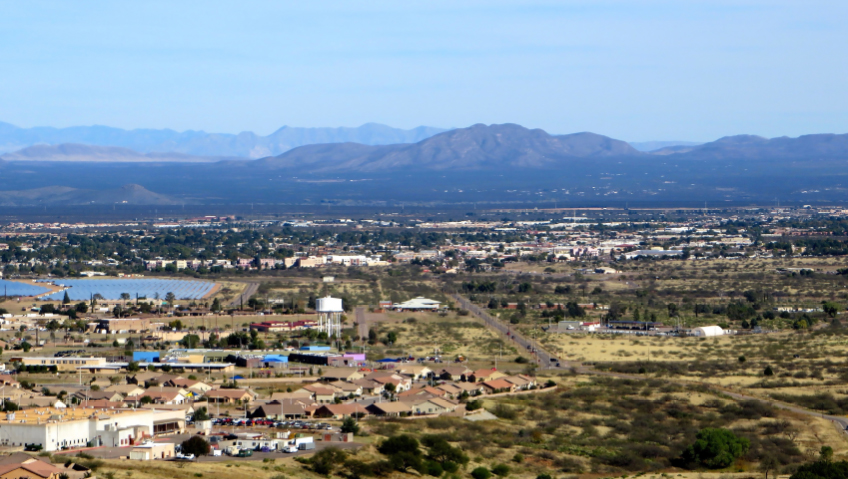Cochise County, Arizona delivers a generous range of growth and development opportunities due to its low taxes, affordable commercial space, land availability, low cost of living, quality healthcare and education, convenient access to railways and Interstate 10, and an educated, bilingual workforce. Nestled high in the mountains, this rural community of 125,447 people enjoys a mild climate and a wealth of outdoor activities and destinations within a stunning western landscape, from hiking and mountain biking to water sports in Parker Canyon Lake, to vineyards and community festivals.
“Cochise County is a great place to live, raise a family, and retire,” says Director of Development Services Daniel Coxworth. “Gentle seasons compared to the harsh heat in other parts of the state make it an ideal place to enjoy the vast outdoor recreational opportunities. To me, Cochise County is a very easy place to live.”
People from around the country have taken note of these attributes and relocated to Cochise County for its lifestyle and amenities. “A great percentage of the people who are here now are not natives of the area,” says Cochise County Chair of the Board of Supervisors Ann English. “They have come here either for jobs or for the recreational opportunities, the hiking trails, the parks, the vistas that we have, and to get away from the heat in the Tucson area because we’re a little cooler than there.” English can certainly vouch for the area; she moved there 58 years ago and never left.
The community’s relaxed atmosphere is a key attractor. “A lot of people are coming out here to what I would say are very rural properties, wanting to have a different lifestyle, wanting to get away from the hustle and bustle,” English says. Younger people often seek out “that hustle and bustle, but when you have a family, sometimes you want a calmer atmosphere, and we certainly have that. We have a different lifestyle here. You’re able to see neighbors at the grocery store. You also have the opportunity to be by yourself when you go to the mountains and go for a walk or go to one of the vistas so that you can just look out and just commune with nature. So [we have] things that people, once they have survived the rat race, are looking for, and we want to be welcoming to those people.”
Tourists flock to the county in addition to new residents. “We have many things that attract people,” says English. “Hummingbirds, mountains, trails, history, the mining museum in Bisbee, and the western museum in Willcox, all kinds of things that people could do.”
The community also offers a range of opportunities for business and beyond. “Cochise County is very large, and different regions of the county provide different opportunities,” Coxworth says. “Western Cochise County provides growth opportunities. As the state’s population continues to grow, residential growth opportunities exist for retirees looking for a high quality of life and standard of living. The U.S. Army Installation Fort Huachuca is a $2 billion economic engine in southeast Arizona, providing high-quality, high-tech jobs. Cochise Community College is responsive to training a workforce that supports the local economy, most notably the college’s cyber security program.”
“Central and eastern Cochise County is more rural and provides opportunities in agriculture, such as the county’s wine industry which produces over seventy percent of the grapes used in Arizona wines,” says Coxworth. “The moderate climate and quality water support the recreational and medical marijuana industry and traditional farming. In addition, wide-open spaces and availability of land provide opportunities for alternative power generation from solar and wind.”
“Most importantly, Cochise County shares its southern border with Mexico, which provides access to Mexico’s emerging markets and economy,” Coxworth says. This access is improving with a major, game-changing project that will revitalize and expand the current port of entry between Cochise County and Mexico.
“The biggest thing that the Board of Supervisors has been working toward for many years is to establish a commercial port of entry,” says English. The current port of entry, she adds, “is inadequate. It’s historical. It’s limited in size. It’s limited in space.”
The new plan brings a two-port solution. The original port located in Douglas, Arizona, will be re-vamped into a state-of-the-art facility exclusively for pedestrian, vehicular, and bus traffic. A new port about five miles away will divert the steady flow of oversized and overweight trucks that support major mining and smelter developments in nearby communities. These trucks often disrupt cross-border traffic and can be an environmental threat due to the hazardous material they carry, so their removal will be a huge boon for locals.
The change will “certainly revitalize the place where people come across to shop, visit family, et cetera,” English says. In addition, the new, dedicated commercial port is predicted to be an economic catalyst for the area, bringing in industries such as warehousing that are related to port activities.
The two-port solution has drawn support from the entire region. “From the very beginning we gained support from all of the counties in southeast Arizona through our Southeast Arizona Government Organization,” English says. “So this wasn’t a Cochise County or Douglas effort. We all realized that having better ports with better security is good for Cochise County. It’s good for Southeast Arizona. It’s good for the state of Arizona, and it’s good for the U.S. We need to enhance the trade that we have already started with our best trading partner, which is Mexico, but make sure that we do it in a safe and secure manner.”
The efforts have also strengthened relationships with partnering communities in Mexico, “because we are both working for a common goal,” English says. “It will be a win-win for the Country of Mexico and the State of Sonora, as well as Agua Prieta,” the Mexican city located on the other side of the port.
The Bisbee-Douglas International Airfield provides another means of access to the community. Owned and operated by Cochise County, the airport is strategically located ten miles north of the U.S./Mexico border and supports businesses in the Douglas area as well as manufacturing, warehousing, and distribution businesses in Mexico. “The airport further provides an opportunity to support new businesses and expand industries when the new commercial port opens,” Coxworth points out.
The county and the Federal Aviation Administration are working together to modernize the terminal building to include tenant space for lease and other airfield revitalization projects. “The airport presents an opportunity for economic development with up to 600 acres of developable land for lease and favorable lease terms for businesses that invest in the airport and provide jobs in the region,” he reports.
Cochise County works hard to cultivate any opportunities for future development while simultaneously protecting the environment and laid back local lifestyle. “We are looking at what our assets are and how we can best leverage those assets to encourage more investments and investors coming to Cochise County to support and help our local economy from an economic development perspective,” says Coxworth. “We’re always looking for opportunities to reduce barriers to investment in the county while still protecting what makes Cochise County such a wonderful place to live, [to] still be a beautiful place with great water and great air. So we have a balance, but we’re very aggressive in encouraging investment in Cochise County.”
This commitment to the environment is seen in a major brownfield cleanup effort. In 2019, the U.S. Environmental Protection Agency (EPA) awarded Cochise County a $600,000 brownfield assessment grant to transform underused commercial properties from liabilities to assets and breathe new life into residential communities. The initial effort proved so successful that the EPA granted Cochise County an additional $500,000 to continue the work.
The future looks bright for Cochise County. “The new commercial port of entry is a game-changer for the county,” Coxworth says. “Although still a few years away, the county is actively amending the county’s Comprehensive Land Use Plan to support the private investment that will follow. The county is also taking a leadership role, coordinating efforts to ensure the necessary infrastructure to support the new port.” The community’s balanced approach is sure to bring a positive outcome for all. “The county foresees a prosperous future by supporting responsible growth that cares for our natural resources and provides a business-friendly environment to take advantage of the numerous available opportunities,” Coxworth summarizes.






